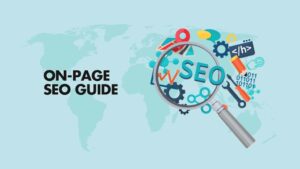The role of on-page optimization
On-page optimization is one of the most important aspects of SEO. It refers to the process of making your website more visible and relevant to search engines. There are a number of factors that contribute to on-page optimization, and each one is important in its own way.
One of the most important aspects of on-page optimization is the use of keywords. Keywords are the terms that people use when they search for information on the internet. When you use keywords correctly, you can make your website more visible in search engine results pages. This will help you attract more visitors to your website.
Another important aspect of on-page optimization is the use of metatags. Metatags are the tags that you use to describe your website. They help search engines understand what your website is about. When you use metatags correctly, you can improve your website’s visibility in search engine results pages.
The title tag is another important aspect of on-page optimization. The title tag is the text that appears in the blue bar at the top of your web browser. It is the text that appears when someone searches for your website. The title tag should be descriptive and concise. It should contain keywords that relate to your website.
The meta description is another important aspect of on-page optimization. The meta description is the text that appears beneath the title tag in the search engine results pages. It should be interesting and descriptive. It should contain keywords that relate to your website.
The URL is another important aspect of on-page optimization. The URL is the address of your website. It should be easy to remember and easy to type. It should contain keywords that relate to your website.
The header tags are another important aspect of on-page optimization. Header tags are the tags that you use to structure the content on your website. They help search engines understand the hierarchy of your website. When you use header tags correctly, you can improve your website’s visibility in search engine results pages.
The anchor text is another important aspect of on-page optimization. Anchor text is the text that you use to link to other websites. When you use anchor text correctly, you can improve your website’s visibility in search engine results pages.
The alt text is another important aspect of on-page optimization. Alt text is the text that appears when an image cannot be displayed. It should be descriptive and concise. It should contain keywords that relate to your website.
These are just a few of the many factors that contribute to on-page optimization. If you want to improve your website’s visibility in search engine results pages, you nee
Here are some key aspects of the role of on-page optimization
-
Keyword Optimization: On-page optimization involves strategically placing relevant keywords in key areas of a web page, such as the title tag, meta description, headers, and content. This helps search engines understand the page’s topic and improves its chances of ranking for those keywords.
-
High-Quality Content: Creating high-quality, valuable, and relevant content is essential for on-page optimization. Engaging content not only attracts visitors but also encourages them to stay on the page longer, reducing bounce rates.
-
Meta Tags: Properly crafting meta tags, including the title tag and meta description, is important. The title tag should accurately describe the page’s content and include relevant keywords. The meta description provides a brief summary of the page’s content and can influence click-through rates.
-
Header Tags: Proper use of header tags (H1, H2, H3, etc.) helps organize content and improve readability. Search engines use header tags to understand the hierarchy and importance of content on a page.
-
Optimizing Images: Images should be optimized for both search engines and user experience. This includes using descriptive file names, adding alt text, and compressing images to improve page load times.
-
Internal and External Links: On-page optimization involves adding relevant internal links to other pages within your website, as well as external links to authoritative sources. This helps search engines understand the context of your content and provides value to users.
-
Mobile-Friendliness: Ensuring that your web pages are responsive and mobile-friendly is crucial, as mobile optimization is a ranking factor for search engines.
-
Page Speed: Fast-loading pages are favored by both users and search engines. Optimizing page speed involves minimizing code, using efficient server hosting, and optimizing images and other media.
-
Schema Markup: Implementing schema markup can enhance how search engines display your content in SERPs, making it more appealing and informative to users.
-
User Experience: User experience is a significant factor in on-page optimization. Ensure that your website is easy to navigate, with clear calls to action and a user-friendly design.
-
Content Updates: Regularly updating and refreshing content can signal to search engines that your website is relevant and current.
-
Analytics and Monitoring: On-page optimization is an ongoing process. It’s essential to monitor your website’s performance using tools like Google Analytics and make adjustments as needed.
In summary, on-page optimization is a fundamental part of SEO that focuses on optimizing individual web pages to improve their rankings in search results and provide a better experience for users. It involves a combination of keyword optimization, content quality, technical improvements, and user experience enhancements.

